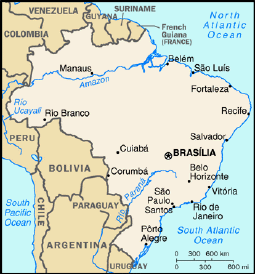



Introduction Brazil has a population of 146 Million people concentrated on its two hundred miles of east coast. Over 90 percent of the people live on 10 percent of the land, and over 15 Million live in Sao Paulo and Rio de Janeiro. Brazil’s ethnic composition is 55 percent European descent (primarily Portuguese), 38 percent a mixture of cultures (African, German, Japanese, Amerindian, and so forth), 6 percent African, and only 1 percent Amerindian. Brazil is a multiparty federal republic. The president is both the chief of state and the head of the government. There are two legislative houses: an 81 member Senate and a 503-member Chamber of Deputies. Portuguese is the official language, although some of the population speak Spanish, Italian, or various Amerindian languages. There is no official religion, however the predominant religion is Roman Catholic (about 90 percent of the population). Some 16 percent practice Afro-Brazilian religions that combine tribal and Catholic beliefs (Spiritual Catholics) and Evangelical Catholics make up 9 percent. Protestants, Judaism, Buddhism, and other religions account for less than 9 percent. |
||
|
||
| Fun Fact Nearly
50 percent of the population is under twenty years of age. Despite
massive economic problems, Brazil
is often regarded as a potentially rich country with a strong industrial
sector, large agricultural production, and rich natural resources.
An example of its potential for efficient utilization of resources
is its processing of sugarcane into ethyl alcohol for fueling 1.5 Million
Brazilian cars. |
||
|
||
Geert
Hofstede Analysis
|
||
The Geert Hofstede analysis for Brazil is similar to it’s Latin American neighbors. Uncertainty avoidance ranks highest which indicates a high concern for rules, regulations, controls and issues with career security – typically, a society that does not readily accept change and is risk adverse. A large power distance indicates that inequalities of power and wealth have been allowed to grow with Brazilian society. High long-term orientation ranking signifies Brazil has respect for tradition and supports a strong work ethic where long term rewards are expected as a result of today’s work. More Details |
||
Appearance
|
||
|
Behavior
|
||
|
Communications
|
||
Countries
|
||
Africa Argentina Australia Brazil Canada Chile China Colombia Costa Rica Ecuador Egypt El Salvador France Germany Great Britain Guatemala Hong Kong India Indonesia Italy Japan Mexico New Zealand Panama Russia Saudi Arabia Spain Taiwan United Arab Emirates United States Venezuela |
||
Regions
|
||
Resources |
||
Thanks
to the Global MBA graduates that work diligently on collecting the
information on this site
University of Texas at Dallas - M.B.A. International Management Studies |
||
Page authored by: Joni Nicol |
||
|
||
© 2003
international-business-center.com - all rights reserved
|
||